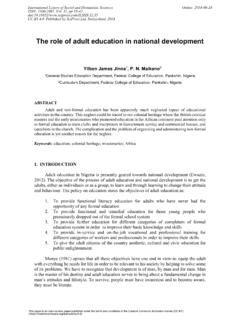Transcription of EFFECTIVE PRACTICE IN INCLUSIVE AND SPECIAL NEEDS ...
1 INTERNATIONAL JOURNAL OF SPECIAL education Vol 31, No: 1, 2016. EFFECTIVE PRACTICE IN INCLUSIVE AND SPECIAL NEEDS education . Jorun Buli-Holmberg University of Oslo Sujathamalini Jeyaprathaban Alagappa University The present study attempts to evaluate the EFFECTIVE teaching PRACTICE for children with SPECIAL learning NEEDS . The research question framed in the present study for investigation is which PRACTICE will be EFFECTIVE in different INCLUSIVE classroom settings and what are the factors that contribute for EFFECTIVE practices?
2 Qualitative research was carried out in the present study using the case study method of embedded single case design to answer the research question. This study was carried out in South Norway. Twenty four Schools from four municipalities in three counties were sampled for the present study. Eighty three observations were carried out in the classrooms of selected schools where different INCLUSIVE classroom PRACTICE was followed. The study observed different INCLUSIVE classroom settings namely traditional PRACTICE , variety and flexible PRACTICE , one to one support PRACTICE outside and within the classroom and small groups outside the classroom.
3 The investigators derived different criterion under three categories: 1) interaction 2). support and 3) adaptation for analysing the best INCLUSIVE classroom practices. The following criteria were used under the interaction category; teacher interaction and collaboration, teacher and students interaction and collaboration. The criteria used in the support category are general teacher support, SPECIAL teacher support, teacher supporting student participating in the learning community. The adaptation category has following criteria; classroom facilitation, learning materials and teachers instructions.
4 The result of the study showed that each type of PRACTICE has its own advantages and disadvantages in the education of children with SPECIAL NEEDS . The strength and weakness of each PRACTICE were analysed. The finding from the traditional PRACTICE shows that those students that need SPECIAL support do not get the support they need to master their learning. Under the one to one support PRACTICE the students got the support they needed to master their learning and they had positive interaction with the teacher in the students' learning process, and the same results were found with one to one support inside the classroom.
5 In small group PRACTICE the students had more support and a closer interaction with the teacher than in the traditional PRACTICE . The present study concluded that varied and flexible PRACTICE in the classroom had met all the criteria listed by the investigators and served the necessary learning requirements of children with SPECIAL NEEDS . Whereas the remaining four practices had served children with SPECIAL need to a certain extent only. The study stated that there is a lack of expertise on the part of the general teachers to deliver adapted teaching learning process in an INCLUSIVE classroom PRACTICE .
6 The study implied a need to build competencies on the part of the general teachers and provide necessary teaching - learning interaction, support and adaptation in all type of INCLUSIVE practices. Introduction This research paper dealt with the EFFECTIVE practices in INCLUSIVE and SPECIAL NEEDS education . INCLUSIVE education means that all students in a school, regardless of their strengths or weaknesses in any area, become part of the school community. The term Inclusion generally means ending all separate SPECIAL education placement for all students and full time placement in general education with appropriate SPECIAL education supports within that classroom (Garvar- Pinhas & SchmelkinPedhazur, 1989; Lipsky & Gartner, 1996).
7 There are some individuals who by virtue of their physical and mental abilities require a more relevant or appropriate instruction than is usually available within formal and informal educational structures. A domain of education has been constructed to satisfy their learning 119. INTERNATIONAL JOURNAL OF SPECIAL education Vol 31, No: 1, 2016. requirements (Laura & Ashman, 1985). This domain is called SPECIAL NEEDS education '. This field of SPECIAL NEEDS education encompasses heterogeneous groups who demand varied services: visually impaired, hearing impaired, mentally retarded, orthopaedic handicapped, children with behaviour disorders, gifted or talented and finally the learning disabled or children with learning difficulties.
8 SPECIAL NEEDS education meets the NEEDS of children with specially designed instructional programme to compensate/overcome their disabilities/difficulties. In past, the learning requirements of these children were provided in SPECIAL settings, such as SPECIAL classes, SPECIAL schools and SPECIAL residential schools or institutions. Recently, inclusion emerges out with the constitutional provision of equal opportunity for all these individuals. The concept of integration' stemmed out from the perspective of democracy. Integration leading to INCLUSIVE schools cannot be about renegotiating the roles of SPECIAL ' educators to meet the NEEDS of SPECIAL ' children in ordinary classrooms (Stainback, Stainback & Forest, 1989, ).
9 To achieve a quality in INCLUSIVE education school plays vital role. All individuals are unique and SPECIAL ' with their strengths and weaknesses. As education binds us together, it has its root in the past and is meant to equip us for the future. It transfers knowledge, culture and values from one generation to the next. It promotes social mobility and ensures the creation of values and welfare for all. For the individual, education is to contribute to cultural and moral growth, mastering social skills and learning self-sufficiency.
10 It passes on values and imparts knowledge and tools that allow every one to make full use of their abilities and realise their talents. It is meant to cultivate and educate so that individuals can accept personal responsibility for themselves and their fellows. education must make it possible for an individual or a person to develop so that they can make well-founded decisions and influence their own future. It is all about participating in a society to a maximum extent for a successful life. Inclusion is a concept where social and cultural interactions are the main focus (Buli-Holmberg & Ekeberg, 2009).












